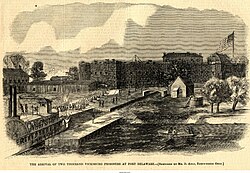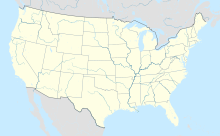39°35′24″N 75°34′19″W / 39.59000°N 75.57194°W
| Fort Delaware | |
|---|---|
| Part of American Civil War prison camps 1861–1865 Harbor Defenses of the Delaware 1898–1945 | |
| Fort Delaware, Pea Patch Island, New Castle County, Delaware, United States | |
 Fort Delaware during the American Civil War | |
| Type | Garrison Fort, Training Camp, Union Prison Camp |
| Site information | |
| Owner | U.S. Government |
| Controlled by | Union Army |
| Open to the public | Yes |
Fort Delaware | |
 Fort Delaware on Pea Patch Island | |
| Location | Fort Delaware State Park, Pea Patch Island, New Castle County, Delaware, USA |
| Nearest city | Delaware City, Delaware |
| Area | 288 acres |
| Built | 1846-1868[2] |
| Architect | Joseph G. Totten |
| Architectural style | Third System |
| NRHP reference No. | 71000226[1] |
| Added to NRHP | December 16, 1971 |
| Site history | |
| In use | 1846–1945 |
| Battles/wars | American Civil War World War I World War II |
| Garrison information | |
| Occupants | U.S. Army soldiers, Confederate prisoners of war |

Fort Delaware is a former harbor defense facility, designed by chief engineer Joseph Gilbert Totten and located on Pea Patch Island in the Delaware River.[3] During the American Civil War (1861-1865), the Union / United States Department of War / United States Army used Fort Delaware as a prison for Confederate prisoners of war, political prisoners, miscellaneous civilians, federal convicts, and privateer officers.
A three-gun concrete battery of 12-inch guns, later named Battery Torbert, was designed by Maj. Charles W. Raymond and built inside the fort in the 1890s. By 1900, the fort was part of a three fort concept, the first forts of the Coast Defenses of the Delaware, working closely with Fort Mott further upstream on the opposite shore, in Pennsville, New Jersey, and Fort DuPont downstream in Delaware City, Delaware. The fort and the island currently belong to the Delaware Department of Natural Resources and Environmental Control (DNREC) and encompass a living history museum, located in Fort Delaware State Park.
- ^ "National Register Information System". National Register of Historic Places. National Park Service. April 15, 2008.
- ^ Dobbs, Kelli W.; Siders, Rebecca J. Fort Delaware Architectural Research Project. Newark, DE: University of Delaware, Center for Historic Architecture and Design, 1999.
- ^ Dobbs, Kelli W., et al.


